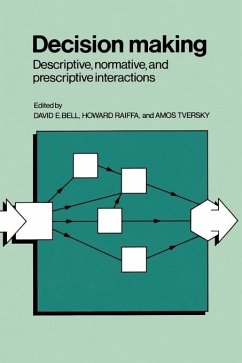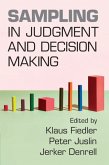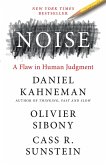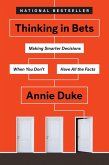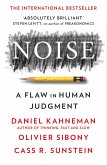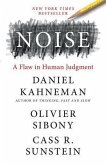E. Bell / Howard Raiffa / Amos Tversky (eds.)
Decision Making
Descriptive, Normative and Prescriptive Interactions
Herausgeber: Bell, David E.; Tversky, Amos; Raiffa, Howard
E. Bell / Howard Raiffa / Amos Tversky (eds.)
Decision Making
Descriptive, Normative and Prescriptive Interactions
Herausgeber: Bell, David E.; Tversky, Amos; Raiffa, Howard
- Broschiertes Buch
- Merkliste
- Auf die Merkliste
- Bewerten Bewerten
- Teilen
- Produkt teilen
- Produkterinnerung
- Produkterinnerung
The analysis of decision making under uncertainty has again become a major focus of interest. This volume, based on a conference at Harvard Business School, brings together different approaches to decision making - normative, descriptive and prescriptive - which largely correspond to different disciplinary interests of mathematics, psychology, operations research.
Andere Kunden interessierten sich auch für
![The Cambridge Handbook of Psychology and Legal Decision-Making The Cambridge Handbook of Psychology and Legal Decision-Making]() The Cambridge Handbook of Psychology and Legal Decision-Making77,99 €
The Cambridge Handbook of Psychology and Legal Decision-Making77,99 €![Sampling in Judgment and Decision Making Sampling in Judgment and Decision Making]() Sampling in Judgment and Decision Making55,99 €
Sampling in Judgment and Decision Making55,99 €![Thinking in Bets Thinking in Bets]() Annie DukeThinking in Bets23,99 €
Annie DukeThinking in Bets23,99 €![Noise Noise]() Daniel KahnemanNoise13,99 €
Daniel KahnemanNoise13,99 €![Thinking in Bets Thinking in Bets]() Annie DukeThinking in Bets31,99 €
Annie DukeThinking in Bets31,99 €![Noise Noise]() Daniel KahnemanNoise14,99 €
Daniel KahnemanNoise14,99 €![Noise Noise]() Daniel KahnemanNoise9,49 €
Daniel KahnemanNoise9,49 €-
-
-
The analysis of decision making under uncertainty has again become a major focus of interest. This volume, based on a conference at Harvard Business School, brings together different approaches to decision making - normative, descriptive and prescriptive - which largely correspond to different disciplinary interests of mathematics, psychology, operations research.
Hinweis: Dieser Artikel kann nur an eine deutsche Lieferadresse ausgeliefert werden.
Hinweis: Dieser Artikel kann nur an eine deutsche Lieferadresse ausgeliefert werden.
Produktdetails
- Produktdetails
- Verlag: Cambridge University Press
- Seitenzahl: 636
- Erscheinungstermin: 19. Oktober 1988
- Englisch
- Abmessung: 229mm x 152mm x 37mm
- Gewicht: 934g
- ISBN-13: 9780521368513
- ISBN-10: 0521368510
- Artikelnr.: 22017895
- Herstellerkennzeichnung
- Books on Demand GmbH
- In de Tarpen 42
- 22848 Norderstedt
- info@bod.de
- 040 53433511
- Verlag: Cambridge University Press
- Seitenzahl: 636
- Erscheinungstermin: 19. Oktober 1988
- Englisch
- Abmessung: 229mm x 152mm x 37mm
- Gewicht: 934g
- ISBN-13: 9780521368513
- ISBN-10: 0521368510
- Artikelnr.: 22017895
- Herstellerkennzeichnung
- Books on Demand GmbH
- In de Tarpen 42
- 22848 Norderstedt
- info@bod.de
- 040 53433511
Preface; Introduction; Part I. Overview Paper: 1. Descriptive, normative,
and prescriptive interactions in decision making David E. Bell, Howard
Raiffa, and Amos Tversky; Part II. Conceptions of Choice: 2. Bounded
rationality, ambiguity, and the engineering of choice James G. March; 3.
Rationality as process and as product of thought Herbert A. Simon; 4.
Normative theories of decision making under risk and under uncertainty P.
C. Fishburn; 5. Risky choice revisited David E. Bell, and Howard Raiffa; 6.
Behavioral decision theory: processes of judgment and choice Hillel J.
Einhorn, and Robin M. Hogarth; 7. Reply to commentaries Hillel J. Einhorn,
and Robin M. Hogarth; 8. Response mode, framing, and information-processing
effects in risk assessment Paul Slovic, Baruch Fischhoff, and Sarah
Lichetenstein; 9. Rational choice and the framing of decisions Amos
Tversky, and Daniel Kahneman; 10. Savage revisited Glenn Shafer; Part III.
Beliefs and Judgments about Uncertainties: 11. Languages and decisions for
probability judgment Glenn Shafer, and Amos Tversky; 12. Updating
subjective probability Persi Diaconis, and Sandy L. Zabell; 13.
Probability, evidence, and judgment A. P. Dempster; 14. The effects of
statistical training on thinking about everyday problems Geoffrey T. Fong,
David H. Krantz, and Richard E. Nisbett; Part IV. Values and Utilities: 15.
The mind as a consuming organ T. C. Schelling; 16. Disappointment in
decision making under uncertainty David E. Bell; 17. Marginal value and
intrinsic risk aversion David E. Bell, and Howard Raiffa; 18. Knowing what
you want: measuring labile values Baruch Fischhoff, Paul Slovic, and Sarah
Lichetenstein; 19. Sources of bias in assessment procedures for utility
functions John C. Hershey, Howard C. Kunreuther, and Paul J. H. Schoemaker;
20. Simplicity in decision analysis: an example and a discussion Ward
Edwards, Detlof von Winterfeldt, and David L. Moody; 21. Value-focused
thinking and the study of values Ralph L. Keeney; Part V. Areas of
Application: 22. Behaviour under uncertainty and its implications for
policy Kenneth J. Arrow; 23. The relevance of quasi rationality in
competitive markets Thomas Russell, and Richard Thaler; 24. How senior
managers think Daniel J. Isenberg; 25. Problems in producing usable
knowledge for implementing liberating alternatives Chris Argyris; 26. On
the framing of medical decisions Barbara J. McNeil, Stephen G. Pauker, and
Amos Tversky; 27. Whether or not to administer amphotericin to an
immunosuppressed patient with hematologic malignancy and undiagnosed fever
Jonathan E. Gottlieb, and Stephen G. Pauker; 28. The effect of private
attitudes on public policy: prenatal screening for neural tube defects as a
prototype Stephen G. Pauker, Susan P. Pauker, and Barbar J. McNeil; 29.
Discussion agenda for the session on medical decision making and minutes of
a group discussion clinical decision making Milton C. Weinstein,
(moderator), and Harvey V. Fineberg, Barbara J. McNeil, and Stephen G.
Pauker (discussion rapporteur Robert J. Quinn).
and prescriptive interactions in decision making David E. Bell, Howard
Raiffa, and Amos Tversky; Part II. Conceptions of Choice: 2. Bounded
rationality, ambiguity, and the engineering of choice James G. March; 3.
Rationality as process and as product of thought Herbert A. Simon; 4.
Normative theories of decision making under risk and under uncertainty P.
C. Fishburn; 5. Risky choice revisited David E. Bell, and Howard Raiffa; 6.
Behavioral decision theory: processes of judgment and choice Hillel J.
Einhorn, and Robin M. Hogarth; 7. Reply to commentaries Hillel J. Einhorn,
and Robin M. Hogarth; 8. Response mode, framing, and information-processing
effects in risk assessment Paul Slovic, Baruch Fischhoff, and Sarah
Lichetenstein; 9. Rational choice and the framing of decisions Amos
Tversky, and Daniel Kahneman; 10. Savage revisited Glenn Shafer; Part III.
Beliefs and Judgments about Uncertainties: 11. Languages and decisions for
probability judgment Glenn Shafer, and Amos Tversky; 12. Updating
subjective probability Persi Diaconis, and Sandy L. Zabell; 13.
Probability, evidence, and judgment A. P. Dempster; 14. The effects of
statistical training on thinking about everyday problems Geoffrey T. Fong,
David H. Krantz, and Richard E. Nisbett; Part IV. Values and Utilities: 15.
The mind as a consuming organ T. C. Schelling; 16. Disappointment in
decision making under uncertainty David E. Bell; 17. Marginal value and
intrinsic risk aversion David E. Bell, and Howard Raiffa; 18. Knowing what
you want: measuring labile values Baruch Fischhoff, Paul Slovic, and Sarah
Lichetenstein; 19. Sources of bias in assessment procedures for utility
functions John C. Hershey, Howard C. Kunreuther, and Paul J. H. Schoemaker;
20. Simplicity in decision analysis: an example and a discussion Ward
Edwards, Detlof von Winterfeldt, and David L. Moody; 21. Value-focused
thinking and the study of values Ralph L. Keeney; Part V. Areas of
Application: 22. Behaviour under uncertainty and its implications for
policy Kenneth J. Arrow; 23. The relevance of quasi rationality in
competitive markets Thomas Russell, and Richard Thaler; 24. How senior
managers think Daniel J. Isenberg; 25. Problems in producing usable
knowledge for implementing liberating alternatives Chris Argyris; 26. On
the framing of medical decisions Barbara J. McNeil, Stephen G. Pauker, and
Amos Tversky; 27. Whether or not to administer amphotericin to an
immunosuppressed patient with hematologic malignancy and undiagnosed fever
Jonathan E. Gottlieb, and Stephen G. Pauker; 28. The effect of private
attitudes on public policy: prenatal screening for neural tube defects as a
prototype Stephen G. Pauker, Susan P. Pauker, and Barbar J. McNeil; 29.
Discussion agenda for the session on medical decision making and minutes of
a group discussion clinical decision making Milton C. Weinstein,
(moderator), and Harvey V. Fineberg, Barbara J. McNeil, and Stephen G.
Pauker (discussion rapporteur Robert J. Quinn).
Preface; Introduction; Part I. Overview Paper: 1. Descriptive, normative,
and prescriptive interactions in decision making David E. Bell, Howard
Raiffa, and Amos Tversky; Part II. Conceptions of Choice: 2. Bounded
rationality, ambiguity, and the engineering of choice James G. March; 3.
Rationality as process and as product of thought Herbert A. Simon; 4.
Normative theories of decision making under risk and under uncertainty P.
C. Fishburn; 5. Risky choice revisited David E. Bell, and Howard Raiffa; 6.
Behavioral decision theory: processes of judgment and choice Hillel J.
Einhorn, and Robin M. Hogarth; 7. Reply to commentaries Hillel J. Einhorn,
and Robin M. Hogarth; 8. Response mode, framing, and information-processing
effects in risk assessment Paul Slovic, Baruch Fischhoff, and Sarah
Lichetenstein; 9. Rational choice and the framing of decisions Amos
Tversky, and Daniel Kahneman; 10. Savage revisited Glenn Shafer; Part III.
Beliefs and Judgments about Uncertainties: 11. Languages and decisions for
probability judgment Glenn Shafer, and Amos Tversky; 12. Updating
subjective probability Persi Diaconis, and Sandy L. Zabell; 13.
Probability, evidence, and judgment A. P. Dempster; 14. The effects of
statistical training on thinking about everyday problems Geoffrey T. Fong,
David H. Krantz, and Richard E. Nisbett; Part IV. Values and Utilities: 15.
The mind as a consuming organ T. C. Schelling; 16. Disappointment in
decision making under uncertainty David E. Bell; 17. Marginal value and
intrinsic risk aversion David E. Bell, and Howard Raiffa; 18. Knowing what
you want: measuring labile values Baruch Fischhoff, Paul Slovic, and Sarah
Lichetenstein; 19. Sources of bias in assessment procedures for utility
functions John C. Hershey, Howard C. Kunreuther, and Paul J. H. Schoemaker;
20. Simplicity in decision analysis: an example and a discussion Ward
Edwards, Detlof von Winterfeldt, and David L. Moody; 21. Value-focused
thinking and the study of values Ralph L. Keeney; Part V. Areas of
Application: 22. Behaviour under uncertainty and its implications for
policy Kenneth J. Arrow; 23. The relevance of quasi rationality in
competitive markets Thomas Russell, and Richard Thaler; 24. How senior
managers think Daniel J. Isenberg; 25. Problems in producing usable
knowledge for implementing liberating alternatives Chris Argyris; 26. On
the framing of medical decisions Barbara J. McNeil, Stephen G. Pauker, and
Amos Tversky; 27. Whether or not to administer amphotericin to an
immunosuppressed patient with hematologic malignancy and undiagnosed fever
Jonathan E. Gottlieb, and Stephen G. Pauker; 28. The effect of private
attitudes on public policy: prenatal screening for neural tube defects as a
prototype Stephen G. Pauker, Susan P. Pauker, and Barbar J. McNeil; 29.
Discussion agenda for the session on medical decision making and minutes of
a group discussion clinical decision making Milton C. Weinstein,
(moderator), and Harvey V. Fineberg, Barbara J. McNeil, and Stephen G.
Pauker (discussion rapporteur Robert J. Quinn).
and prescriptive interactions in decision making David E. Bell, Howard
Raiffa, and Amos Tversky; Part II. Conceptions of Choice: 2. Bounded
rationality, ambiguity, and the engineering of choice James G. March; 3.
Rationality as process and as product of thought Herbert A. Simon; 4.
Normative theories of decision making under risk and under uncertainty P.
C. Fishburn; 5. Risky choice revisited David E. Bell, and Howard Raiffa; 6.
Behavioral decision theory: processes of judgment and choice Hillel J.
Einhorn, and Robin M. Hogarth; 7. Reply to commentaries Hillel J. Einhorn,
and Robin M. Hogarth; 8. Response mode, framing, and information-processing
effects in risk assessment Paul Slovic, Baruch Fischhoff, and Sarah
Lichetenstein; 9. Rational choice and the framing of decisions Amos
Tversky, and Daniel Kahneman; 10. Savage revisited Glenn Shafer; Part III.
Beliefs and Judgments about Uncertainties: 11. Languages and decisions for
probability judgment Glenn Shafer, and Amos Tversky; 12. Updating
subjective probability Persi Diaconis, and Sandy L. Zabell; 13.
Probability, evidence, and judgment A. P. Dempster; 14. The effects of
statistical training on thinking about everyday problems Geoffrey T. Fong,
David H. Krantz, and Richard E. Nisbett; Part IV. Values and Utilities: 15.
The mind as a consuming organ T. C. Schelling; 16. Disappointment in
decision making under uncertainty David E. Bell; 17. Marginal value and
intrinsic risk aversion David E. Bell, and Howard Raiffa; 18. Knowing what
you want: measuring labile values Baruch Fischhoff, Paul Slovic, and Sarah
Lichetenstein; 19. Sources of bias in assessment procedures for utility
functions John C. Hershey, Howard C. Kunreuther, and Paul J. H. Schoemaker;
20. Simplicity in decision analysis: an example and a discussion Ward
Edwards, Detlof von Winterfeldt, and David L. Moody; 21. Value-focused
thinking and the study of values Ralph L. Keeney; Part V. Areas of
Application: 22. Behaviour under uncertainty and its implications for
policy Kenneth J. Arrow; 23. The relevance of quasi rationality in
competitive markets Thomas Russell, and Richard Thaler; 24. How senior
managers think Daniel J. Isenberg; 25. Problems in producing usable
knowledge for implementing liberating alternatives Chris Argyris; 26. On
the framing of medical decisions Barbara J. McNeil, Stephen G. Pauker, and
Amos Tversky; 27. Whether or not to administer amphotericin to an
immunosuppressed patient with hematologic malignancy and undiagnosed fever
Jonathan E. Gottlieb, and Stephen G. Pauker; 28. The effect of private
attitudes on public policy: prenatal screening for neural tube defects as a
prototype Stephen G. Pauker, Susan P. Pauker, and Barbar J. McNeil; 29.
Discussion agenda for the session on medical decision making and minutes of
a group discussion clinical decision making Milton C. Weinstein,
(moderator), and Harvey V. Fineberg, Barbara J. McNeil, and Stephen G.
Pauker (discussion rapporteur Robert J. Quinn).

